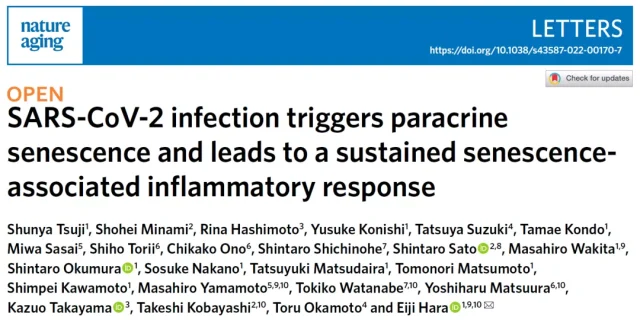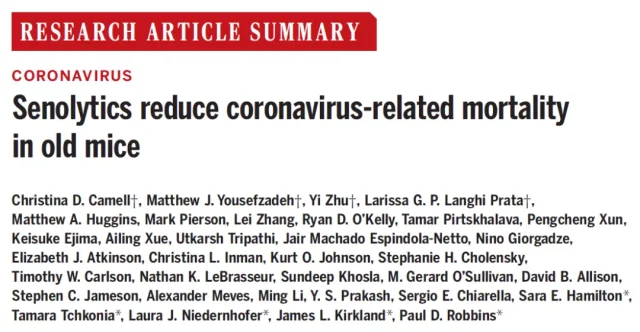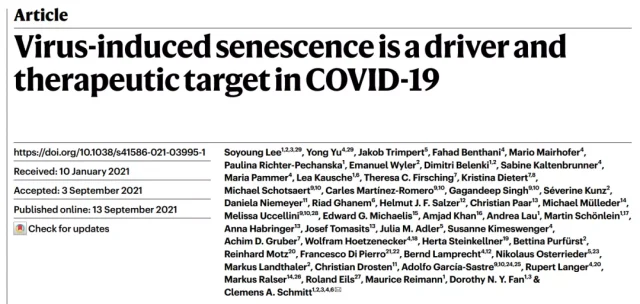COVID-19 promotes cellular senescence leading to long-term sequelae
- Normal Liver Cells Found to Promote Cancer Metastasis to the Liver
- Nearly 80% Complete Remission: Breakthrough in ADC Anti-Tumor Treatment
- Vaccination Against Common Diseases May Prevent Dementia!
- New Alzheimer’s Disease (AD) Diagnosis and Staging Criteria
- Breakthrough in Alzheimer’s Disease: New Nasal Spray Halts Cognitive Decline by Targeting Toxic Protein
- Can the Tap Water at the Paris Olympics be Drunk Directly?
Nature Aging: COVID-19 promotes cellular senescence leading to long-term sequelae
- Should China be held legally responsible for the US’s $18 trillion COVID losses?
- CT Radiation Exposure Linked to Blood Cancer in Children and Adolescents
- FDA has mandated a top-level black box warning for all marketed CAR-T therapies
- Can people with high blood pressure eat peanuts?
- What is the difference between dopamine and dobutamine?
- How long can the patient live after heart stent surgery?
Nature Aging: COVID-19 promotes cellular senescence leading to long-term sequelae.
Since the COVID-19 pandemic began in December 2019, more than 200 million people worldwide have been infected with COVID-19, resulting in more than 5 million deaths.
In addition, a large proportion of people infected with the COVID-19 still have long-term sequelae even after recovery, which is also called ” Long COVID” .
Therefore, a deeper understanding of the biological response after SARS-CoV-2 infection, especially the persistent response, is needed.
Since COVID-19 tends to be more severe in older adults, there may be an important link between COVID-19 infection and aging.
Cellular senescence is an irreversible cell cycle state arrest that can be induced by a variety of potentially oncogenic stimuli and is considered a tumor suppressor mechanism.
Unlike apoptotic cells, senescent cells do not die immediately, but accumulate throughout the body. Importantly, senescent cells are not only non-dividing, they also develop a cellular senescence-associated secretory phenotype (SASP) .
In this phenomenon, senescent cells secrete a variety of pro-inflammatory factors, such as inflammatory cytokines, chemokines, growth factors, and extracellular matrix-degrading enzymes, among others.
Thus, although the induction of cellular senescence primarily acts as a tumor suppressor, the excessive accumulation of senescent cells in vivo due to senescence can adversely affect cellular senescence-associated secretory phenotype (SASP) .
And studies have shown that genetically or pharmacologically removing senescent cells can slow the onset of aging-related inflammatory diseases in aged mice.
Recently, a research team from Osaka University in Japan published a research paper titled: SARS-CoV-2 infection triggers paracrine senescence and leads to a sustained senescence-associated inflammatory response in Nature Aging , a sub-journal of Nature [1].
The study shows that SARS-CoV-2 infects cells and induces a cellular senescence-associated secretory phenotype (SASP) , which affects nearby uninfected cells to experience senescence-like cell cycle arrest, and this effect persists even after SARS-CoV-2 is cleared. .
This suggests to us that the cellular senescence-associated secretory phenotype (SASP) caused by 2019-nCoV infection may be the cause of ” Long COVID ” .

Prior to this, on July 16, 2021, a research team from the University of Minnesota and Mayo Medical Center published a research paper in the journal Science entitled: Senolytics reduce coronavirus-related mortality in old mice [2] . The study showed that the anti-aging drug Senolytics was able to reduce coronavirus-related mortality in aged mice .

On September 13, 2021, researchers from the Charité School of Medicine in Berlin, Germany published a research paper titled: Virus-induced senescence is driver and therapeutic target in COVID-19 in Nature [ 3] .
This study shows that host cells wake up their own cellular senescence mechanisms as a major stress response after being infected with the new coronavirus .
Based on this, the researchers used Senolytics therapy against senescent cells to selectively remove cells infected with the new coronavirus, thereby revealing a new viral treatment option.

In the new study, the research team found that cells infected with SARS-CoV-2 develop a cellular senescence-associated secretory phenotype (SASP) , which in turn triggers senescence-like cell cycle arrest in nearby cells.
In cultured human cells or bronchial organoids, these SARS-CoV-2-induced senescent cells continued to express high levels of a series of inflammatory factors, the so-called cellular senescence-associated secretory phenotype (SASP) , even after SARS-CoV-2 was cleared. , this senescence-associated secretory phenotype also persists.
The study also found increased gene expression of the senescence marker CDKN2A and various cellular senescence-associated secretory phenotype (SASP) factors in acellular cells of many Covid-19 survivors with sequelae .
In addition, mouse experiments found that the mouse model infected with the COVID-19 showed the phenomenon of cellular senescence and cellular senescence-associated secretory phenotype (SASP) 14 days after infection, which persisted even when the new coronavirus could not be detected. , while the use of anti-aging drugs such as Senolytics can reduce cellular senescence and SASP phenomena.
Collectively, this study shows that SARS-CoV-2 infects cells and induces a cellular senescence-associated secretory phenotype (SASP) , thereby affecting senescence-like cell cycle arrest in nearby uninfected cells, and this effect occurs even after SARS-CoV- 2. persisted after being cleared.
This suggests to us that the cellular senescence-associated secretory phenotype (SASP) caused by 2019-nCoV infection may be the cause of ” Long COVID ” .
Reference :
https://www.nature.com/articles/s43587-022-00170-7
https://science.sciencemag.org//373/6552/eabe4832
https://www.nature.com/articles/s41586-021-03995-1
Nature Aging: COVID-19 promotes cellular senescence leading to long-term sequelae
(source:internet, reference only)
Disclaimer of medicaltrend.org
Important Note: The information provided is for informational purposes only and should not be considered as medical advice.



